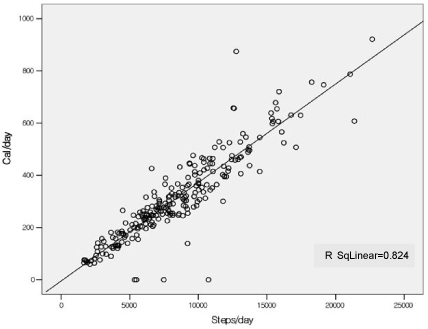J Korean Diabetes Assoc.
2007 Jan;31(1):83-88. 10.4093/jkda.2007.31.1.83.
Pedometer-Determined Physical Activity in Type 2 Diabetes in Korea
- Affiliations
-
- 1Department of Internal Medicine, College of Medicine, The Catholic University of Korea, Korea.
- 2Department of Internal Medicine, Sungkyunkwan University School of Medicine, Korea.
- 3Department of Internal Medicine, Korea University College of Medicine, Korea.
- 4Department of Internal Medicine, Hallym University College of Medicine, Korea.
- 5Department of Internal Medicine, Ewha Womans University College of Medicine, Korea.
- 6Department of Internal Medicine, Yonsei University College of Medicine, Korea.
- 7Department of Internal Medicine, Eulji University College of Medicine, Seoul, Korea.
- KMID: 2008099
- DOI: http://doi.org/10.4093/jkda.2007.31.1.83
Abstract
-
BACKGROUND: Walking is a popular, convenient and relatively safe form of exercise. However, there is few objective data for walking exercise. The aim of this study was to evaluate pedometer-determined physical activity defined as steps/day in type 2 diabetes mellitus. Therefore, it could be the basic data for programming walking exercise in diabetes mellitus.
METHODS
Participants with type 2 diabetes who visited in 6 university hospitals on February, 2006 in Seoul and Kyung-gi area were recruited. The participants were asked their ambulatory activity with the given pedometer and calorimeter for 1 week. Total 240 (Male 122, Female 118) subjects who walked above 1000 steps/day were analyzed. We also collected their biochemical data from the medical records.
RESULTS
Participants took 8532 +/- 4130 steps for day (step/day) and energy expenditure were 320 +/- 161 Cal/day. Steps/day was not significantly different between male and female, but energy expenditure was higher in male than female ( P < 0.05). Steps/day was significantly lower in obese patients than non-obese patients (P < 0.001). BMI (r = -0.325, P < 0.001), waist circumference (r = -0.287, P < 0.001), triglyceride (r = 0.164, P < 0.018) showed significant inverse correlation with steps/day, but BUN (r = 0.165, P = 0.019) and HDL-cholesterol (r = 0.164, P = 0.018) were positive correlated with steps/day significantly. BMI (r = -0.14, P < 0.032) and cholesterol (r = -0.139, P < 0.041) showed significantly inverse correlation with energy expenditure and BUN (r = 0.187, P = 0.008) and HDL cholesterol (r = 0.145, P < 0.037) positively correlated with energy expenditure. Pedometer-determined steps/day was positively associated with energy expenditure (r2 = 0.824, P < 0.001).
CONCLUSION
This study showed the objective quantification of physical activity measured by simple and inexpensive pedometers. It could be used to recommend walking exercise since the practitioners can estimate steps/day for required energy expenditure.
Keyword
MeSH Terms
Figure
Reference
-
2. Ford ES, Herman WH. Leisure-time physical activity patterns in the U.S. diabetic population, Findings from the National Health Interview survey-Health promotion and Disease prevention supplement. Diabetes Care. 1995. 18:27–33.3. Tudor-Locke CE, Ainsworth BE, Whitt MC, Thompson RW, Addy CL, Jones DA. The relationship between pedometer-determined ambulatory activity and body composition variables. Int J Obes Relat Metab Disord. 2001. 25:1571–1578.4. McClung CD, Zahiri CA, Higa JK, Amstutz HC, Schmalzried TP. Relationship between body mass index and activity in hip or knee arthroplasty patients. J Ortho Res. 2000. 18:35–39.5. Tudor-Locke CE, Bell RC, Myers AM, Harris SB, Lauzon N, Rodger NW. Pedometer-determined ambulatory activity in individuals with type 2 diabetes. Diabetes Res Clin Prac. 2002. 55:191–199.6. Tudor-Locke CE, Myers AM. Challenges and opportunities for measuring physical activity in sedentary adults. Spots Med. 2001. 31:91–100.7. Rowlands AV, Eston RG, Ingledew DK. Relationship between activity levels, aerobic fitness, and body fat in 8-10-year-old children. J App Physiol. 1999. 86:1428–1435.8. Chan CB, Spangler E, Valcour J, Tudor-Locke C. Cross-sectional relationship of pedometer determined ambulatory activity to indicator of health. Obes Res. 2003. 11:1563–1570.9. Sugiura H, Sugiura H, Kajima K, Mirbod SM, Iwata H, Matsuoka T. Effects of long-term moderate exercise and increase in number of daily steps on serum lipids in women; randomized controlled trial. BMC Women's Health. 2002. 2:3.10. Tudor-Locker C, Williams JE, Reis JP, Pluto D. Utility of pedometers for assessing physical activity: convergent validity. Sports Med. 2002. 32:795–808.
- Full Text Links
- Actions
-
Cited
- CITED
-
- Close
- Share
- Similar articles
-
- Epidemiology of Physical Activity Participation and Type 2 Diabetes in Korea
- Assessment of Pedometer Counts, Physical Activity Level, Energy Expenditure, and Energy Balance of Weekdays and Weekend in Male High School S tudents
- The Prevention of Type 2 Diabetes Mellitus
- The Study of Daily Physical Activity in Old Women using Pedometer with Accelerometer
- Exercise and Type 2 Diabetes: ACSM and ADA Joint Position Statement


